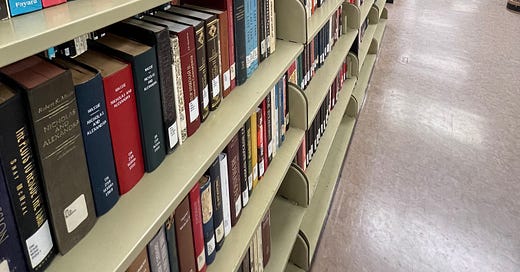In the fall of 1978 I entered as a freshman at USC’s Department of Electrical Engineering. Having matriculated with barely an honor from my Jesuit prep school, I was unprepared for what was next. It was the stacks of Doheny, the main library on campus. The stacks were a low-ceilinged claustrophobic warren of arcane books shot through with the most vulgar graffiti I have ever witnessed, including that of the public bathrooms at Venice Beach.
Some come here to sit and think Others come to shit and stink I just come to scratch my balls And read the writing on the walls
It was difficult for little old me to reconcile the immense wealth of USC’s endowment and its prestigious reputation with the base crudity of its students’ dirty minds. Moreover, these were the stacks, where the presumably most studious of those minds came to find the answers to life’s most enduring questions. Like any freshman, I got an immediate boner thinking I might find a dirty minded Hermione Granger somewhere in a poorly lit corner. The possibilities were stupefying.
UCLA was the alternative I was bullied out of considering owing to the weepy partisanship of my favorite teacher, Miss M, a diehard USC Trojan. I had attended the National Youth Summer Sports Program several years in a row at UCLA’s Westwood campus. I met both Donna de Varona (and taught her how to do the Funky Chicken) and Bobby Bonds who were both coaches. I learned some judo, some volleyball and some long jump over those years. I also learned that I couldn’t do a kip or a giant on the high bar. Then again I was only 10. But like most underprivileged kids, I was somewhat awestruck that I could attend that university. By the time my PSAT came back, I was so inured to that glory that I didn’t even bother to apply, primarily because it meant I would have to take the SAT and the ACT. Since USC was The University, and I was certain I would get in, I ignored the opportunity and failed to take the test. I also assumed that I would get a 3.2 GPA which pretty much guaranteed UC admission in those days without requiring a standardized test. I had no idea how much things could change.
After several decades, many of the memories of UCLA remain, mostly of that Fishbone concert in Ackerman Union, the time I met Bruce Sterling at an ACM meeting, a talk with Martin Amis & Christopher Hitchens at Royce Hall and my refusal to be bothered to find out what the buzz surrounding Laurie Anderson was all about. I’ve got a lot of nerve. I wound up taking my kids several times to the Festival of Books which, ironically moved from UCLA to USC over the years. But I think my favorite memory was of the ‘Waffle Iron’ building and the laser demonstration that blasted through a steel plate back when that kind of drama was acceptable during the public Open House. None of that served my weary feet over the weekend when I was trusting Google Maps to direct me to the Charles E. Young Research Library. It gave me 3 different locations, seriously. Is this someone’s idea of a joke?
I don’t know why I expected the Young (on North Charles E. Young Drive) to have a quirky, magical and introspective librarian like something out of a Murakami novel. There was nothing like a large desk in the foyer where such a creature would preside. Instead there were glass doors, security magnetometers and a uniformed guard wearing a mask that did not mask his bored expression. No one greeted me except large stylized fonts and arrows. It felt more like a wide tiled entrance to a sleek modern train station than a library. There were scanning checkout machines with a barebones UI. Three functions, one of which read barcodes on books and the others on library cards. The third one was not help. I walked away in silence. To the left was a glassed in reading room. At my 10 o’clock were clutches of semi-futuristic looking circular sofa pods sparsely populated with quiet students many of whom were logo’d up in the familiar Bruin blue and gold. I sat for a moment, adjusted myself and observed.
Keep reading with a 7-day free trial
Subscribe to Stoic Observations to keep reading this post and get 7 days of free access to the full post archives.




